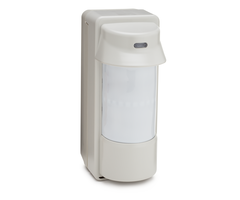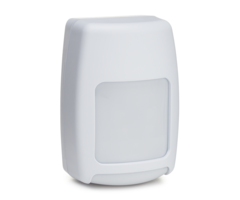Environmental Concerns for Honeywell Dual-Tec and PIR Motion Sensors
Related Products










Related Categories
- Wireless Motion Detecting Sensors
- Wired Motion Detecting Sensors
- Honeywell Six Motion Detectors
- Honeywell 5800 Motion Detectors
Document Transcript
- 1 -
Step-by-Step
Tech Support
Updated 4/10/09
Environmental Concerns for Honeywell’s DUAL TEC®
and Passive Infrared (PIR) motion Detectors
The following explains environmental issues that sh
ould be taken into consideration
with new installations or when troubleshooting prob
lems with Honeywell’s DUAL
TEC® and Passive Infrared (PIR) motion detectors.
Concerns for only DUAL TEC® Motion Detectors
1.
Fluorescent lights
– If there are Fluorescent lights in the detection
area of the
microwave, make sure the detector has the fluoresce
nt light filter feature as to not
interfere with the microwave.
2.
Wireless network Routers
–
DUAL TEC® motion detectors will interrupt or keep
wireless routers from working if the router is usin
g the same frequency as the microwave
in the DUAL TEC® motion detectors. Example: The m
icrowave in the DT500 motion
detector runs at 2.54GHz and the Lynksys WRV54G wir
eless router runs at 2.4GHz.
These frequencies, although slightly different, can
cause a conflict depending on how
close they are together. If you experience this pr
oblem, it is recommended to either
change the wireless routers or the DUAL TEC® to one
that is using a different
frequency, relocate the DUAL TEC® so the microwave
pattern does not cover the router,
or use a PIR detector. There are 3 different frequ
encies that Honeywell’s DUAL TEC®
motions utilize: S-band, X-band, and K-band which
are 2.54GHz, 10.525GHz, and
24.125GHz respectively.
3.
Normal Disturbances
–
Some DUAL TEC® motions have feature called “Enviro
nmental
Adaptation” which means the microwave thresholds ar
e adapted either in hardware or
digitally to remove the effect of low level interfe
rence such as ceiling fans.
Concerns for DUAL TEC® and Passive Infrared Motion
Detectors
4.
Animals/Bugs
– If the premise has pets, make sure the correct d
etector is being used for
pet immunity and follow the instructions from that
detector for installations concerning
pets. Most new models have built-in bug guards to
keep bugs from getting into the
detector and causing false alarms, however, this wi
ll not prevent a spider from crawling
across the lens of the unit which will cause a unit
to trip.
5.
Reflective Surfaces
– Infrared energy can be reflected off of any glos
sy surface such as
mirrors, windows, floors with glossy finish, and sl
ick finished concrete. Some surfaces
will reflect less than others. Example: Detectors
can see a change in infrared energy
reflected off of any reflective surface even if the
heat or cold source is not within the
detection pattern of the detector.
- 2 -
Step-by-Step
Tech Support
Updated 4/10/09
6.
Windows
– Windows cannot only reflect infrared energy, but
they can also allow
sunlight or lights from cars to pass through to the
detector. Example: A detector can
detect a quick change in infrared energy if sun lig
ht comes through a window (which may
not be “seen” by the detector) and shines on a hard
wood floor (which can be “seen” by
the detector). If the change in infrared energy is
quick enough on the floor, the detector
can trip. The same applies if the detector can “se
e” the window, even though the fields of
view cannot “see” through glass. Halogen lights fr
om cars can also pass through the
window at night and directly into the lens of the d
etector. This is when we have to make
sure the detector has the white light immunity feat
ure. The models that have the built-in
bug guard will help since the bug guard is black.
This will help absorb some of that light.
7.
Heating and air registers
– Heating and air registers are also important to
take into
consideration because if they blow air onto an obje
ct within the fields of view, the
temperature of that object could change quickly eno
ugh for the detector to see a change
in infrared energy. Detectors cannot see air curre
nt; only the change in temperature of a
physical object.
8.
Swaying objects
– Anything that can sway or move due to air current
can cause a change
in infrared energy within the fields of view. Heat
and air registers, air drafts from
windows or doors could cause this. Some objects to
be aware of are curtains, blinds,
balloons, loose paper, hanging banners, plants, etc
.
9.
Warm environments
– If a motion detector is desired in a warm environ
ment, make sure
the unit has Advanced (Dual Slope) Temperature Comp
ensation, also known as Bi-
directional Temperature Compensation. If the unit
is in an environment where ambient
temperatures are close to human body temperature an
d cannot compensate for it, it may
not be able to detect a person. Advanced Temperatu
re Compensation will allow the unit
to adjust itself to ambient temperatures within its
environment so it can detect a person in
a room in which its ambient temperature is close to
the human body.
10.
Vibrations
– Make sure the structure that the detector is moun
ted on is sturdy as to not
allow any vibrations. Vibration will not only caus
e the detector to move a little, but this
will also cause the fields of view in the room to m
ove with respect to the detector. A
little vibration can go a long way with the fields
of view, thus the detector can see a
change in energy.
11.
Doors
–
Some installations require detectors to be aimed at
doors. If so, consider the
setup. Detectors can “see” the door move before th
e door contact will initiate an entry
delay and cause a false alarm. If the detector has
to be in this type of location, it is
recommended to program the detector via the control
to initiate an entry delay.
- Uploaded


